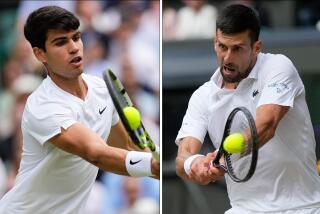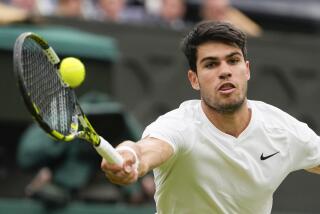Hingis Breaks Up the Act : She Beats Venus to Thwart All-Williams Open Final
- Share via
NEW YORK — Father almost knew best.
Richard Williams was close, so close to realizing the fulfillment of his prediction, an all-Williams teen final at the U.S. Open. What got in the way was an 18-year-old pony-tailed Swiss baseliner with a deceptive smile, the grin of a fiendish competitor.
Martina Hingis had to listen to the talk, all Williams, all the time, for almost a fortnight. On Friday, she watched the younger half of the sister act, 17-year-old Serena Williams, take out the defending champion and second-seeded Lindsay Davenport of Newport Beach in the first semifinal, winning, 6-4, 1-6, 6-4, to reach her first Grand Slam final.
Then, Richard Williams was looking like a prophet when Hingis and his older daughter, 19-year-old Venus, split sets and moved into the third at the National Tennis Center. History books were being dusted off when Venus took a 3-2 third-set lead.
But the top-seeded Hingis quickly collected herself and watched her opponent collapse, as No. 3 Williams dropped the final four games, falling victim to cramps and fatigue. She completely lost her way on her serve, double-faulting 11 times. Williams needed medical treatment just before the last game.
Hingis dropped only three points in the final three games, winning the 2-hour, 1-minute semifinal, 6-1, 4-6, 6-3. This will be her third consecutive U.S. Open final and she is trying to win her second title here. Hingis beat Venus Williams in the ’97 final, and lost to Davenport last year.
For perspective, Serena Williams wasn’t even in the U.S. Open in 1997. And she isn’t intimidated about playing Hingis today in the final. She has defeated Hingis twice in five matches, including last month in the semifinals at Manhattan Beach.
“I fear no one,” Williams said. “I only fear God.”
Even the amusing Hingis knows she can’t keep up with the Williams family off the court, in the battle of quotes.
“It’s a bit nerve-racking when you watch them, and you know you have to be on the court against Venus,” she said. “They’re three against me. With talking, I can’t beat them. I know that. So I have to try to beat them on the court. . . .
“That’s all I can do. I don’t want to fight with words. As I said before, I can’t beat them with words. Because the results and the rankings show it all.”
Said Venus Williams: “I have to wait for another opportunity once again. I’ve had some terrible, terrible losses. This is pretty disappointing too.”
Davenport was feeling the same way. She hit her stride in the second set, winning it in 24 minutes, but couldn’t sustain her momentum in the third.
“It’s disappointing, especially when you lose a close match like that,” she said. “I had some chances; didn’t take advantage of the ones I had. The other day, it went for me. Today, it went against me.
“It’s disappointing, but I’m not ashamed of the way I played today or my performance. I lost to a player who’s a very, very good player. This happens to be her first time in a Grand Slam final, but she’s had a great year.”
Since the seventh-seeded Serena has never defeated her older sister in three meetings, Davenport speculated it would be much easier for her to take on Hingis.
“I think it depends a lot on who she plays. She obviously has a hard time playing her sister,” Davenport said. “Maybe she should want Martina to win.”
Said Hingis: “I was never able at the same tournament to beat both of them. But, you know, hopefully, there is always a first time.”
The parallels are fascinating. Venus made her big splash here two years ago, reaching her first and only Grand Slam final against Hingis. Now, it is Serena’s turn. This is merely her seventh Grand Slam and she handled the pressurized third set like a seasoned veteran of 27, not 17.
The first break point of the third set came at 3-3, and Williams needed only one to topple Davenport. On break point, Davenport fired in a huge serve, Williams lunged and barely got the return back. Surprised by the short return, Davenport scrambled forward and looked off balance, hitting a backhand long.
But Williams faced a stiff test the very next game, the eighth game of the third set, an 11-minute battle of wills. Leading 4-3, Williams faced five break points and finally prevailed after Davenport hit a backhand volley in the net.
“Every break point I had, she just hit a huge, huge first serve,” Davenport said. “I never got a second serve, I don’t think, slower than 105 [mph]. She just played those points really tough and served well.”
Two games later, Williams looked unstoppable as she served for her place in the U.S. Open final. Here’s how nervous she was: Service winner at 115 mph, forehand long, service winner, 108-mph ace and another strong serve that Davenport belted well wide on match point.
So, another star was born. There were hints that this talent, this moxie was there last month in Manhattan Beach. Serena declared she loved attention, loved looking at pictures of herself, saying: “I love to get my daily dose of me.”
Friday, she announced she is collecting pictures of herself from national newspapers and that she is “more or less nocturnal.”
“I mean, I touch everyone,” she said. “Everyone wants to see me. I don’t blame them. ‘Got to get a look at Serena.’ ”
And guess who predicted this? Richard Williams. Michael Wilbon, columnist from the Washington Post, recalled Friday that Richard told him, years ago, that his youngest daughter Serena would end up being the better player.
Maybe father really did know best, after all.
More to Read
Go beyond the scoreboard
Get the latest on L.A.'s teams in the daily Sports Report newsletter.
You may occasionally receive promotional content from the Los Angeles Times.











